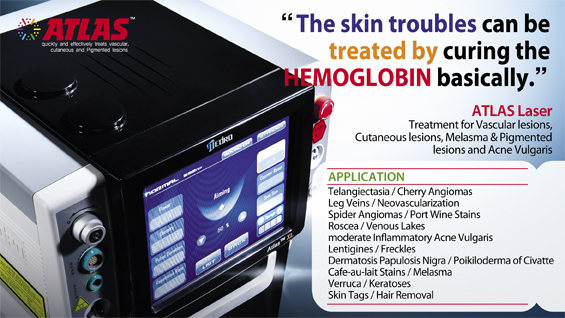▶ Previous Artlcle : #10-2. Development of Hair Removal Lasers II
This article will discuss the major trends in clinical studies examining the efficacy of hair removal lasers. As explained in the previous article, lasers for hair removal can be largely categorized into a long pulse ruby laser, alexandrite laser, diode laser, and Nd:YAG laser. Besides laser, IPL hair removal devices are also being released.
[Advertisement] ATLAS(Long pulse 532nm & 940nm dual wavelength) – Manufacturer: MEDRO(www.medro.net)
The ruby laser for hair removal was introduced in 1996, and during the next two to three years, the focus was placed on whether laser could, in fact, remove hair. At the time, the phrase ‘permanent hair removal’ meant a single procedure resulting in long-term (at least two years) hair removal without regrowth (to be medically accurate, visible regrowth). The key issue at the time was how much hair could be permanently removed with a single procedure. Although questions were raised on why permanent removal of all hairs was not possible with one treatment, it did not stop the use of the phrase ‘permanent hair removal’ to mean only perpetual removal of some hairs. This was because at the time, modalities other than laser did not even come close to the effect of laser. Electrolysis were also used for hair removal, however, as explained earlier, they were uncomfortable, painful, time-consuming and far less effective than laser. As hair removal lasers came to be widespread and less patients experienced the discomforts of electric needles, the term ‘permanent hair removal‘ started raising some questions. As time went on, more consumers began to expect this term to actually mean permanent removal of all hairs. Christine Dierickx, who carried out extensive research of laser hair removal during its early days, argued in her review article published in 2000 that ‘permanent hair loss‘ should be distinguished from ‘complete hair loss‘.
The late 1990s and early 2000s saw an influx of studies reporting clinical efficacy of various hair removal lasers and comparative studies of different lasers published by major medical institutions. However, studies on laser hair removal are fundamentally bound to show incomplete results and no study could claim their results to be confirmatory. (Table 1).

Table 1. Causes of inaccurate outcomes of efficacy studies on laser hair removal.
In short, due to many complex factors, no reliable studies reported which combination of lasers was most effective on permanent hair removal. With lack of accurate results from clinical studies of laser hair removal and little technological progress in hair removal lasers past the 2000s, many famous doctors in this field stopped their research efforts. Moreover, when the Food and Drug Administration of the US started approving lasers for hair removal procedures based only on safety profiles and without clinical data, it further discouraged clinical studies funded by the industry.
Starting the mid-2000s, marketing authorization was easily obtained without the clinical proof of the rate of permanent hair reduction. Newly released hair removal lasers used a reduced wattage to cut cost and thereby brought inferior efficacy.
Finally, the belief that new lasers will always outperform old ones became a misconception. But It seems that the demand for high performance hair removal lasers will likely increase because in the last 6 to 7 years, many new hair removal lasers with inferior efficacy were introduced. Recently new high power diode lasers like LightSheer Duet(Lumenis), Advantage(Lutronic), Vectus(Parloma) are leading this new trend.
Wrapping up the discussion on laser hair removal, I provide a brief description of renowned studies on each laser type.
1. Long Pulse Ruby Laser
This laser was first marketed in 1996 for hair removal but currently is not used for this purpose.
However, all studies on the early phase of laser hair removal used a ruby laser (Grossman MC, Dierickx C, Farinelli W, Flotte T, Anderson RR. Damage to hair follicles by normal-mode ruby laser pulses. J Am Acad Dermatol 1996: 35 (6): 889~894). This laser was more effective in Caucasian patients rather than Asians. Although it was the first hair removal laser introduced in Korea, it is not clear if the ruby laser is still in use for this purpose. Risk of side effects and relative deterioration of efficacy exist as the melanin of the Asian skin more readily absorbs the ruby laser beam(694nm). In 1999, in a study involving 200 subjects, Rox Anderson reported that an average of 4 procedures resulted in at least 75% efficacy 6 months after treatment (Anderson RR, Burns AJ, Garden J, et al. Multicenter study of long-pulse ruby laser hair removal. Lasers Surg Med 1999:11 (Suppl.): 14).
-To be continued-
▶ Next Artlcle : #11-2. Development of Hair Removal Lasers III





















